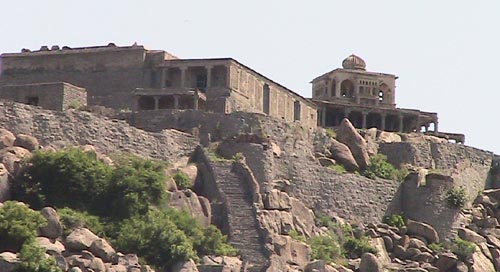Gingee Fort

Information on Gingee Fort (Villupuram, Tamil Nadu) - History & Architecture
Gingee Fort is located in Villupuram District, in the state of Tamil Nadu, in Southern India. This hill fort was initially built by Ananda Konar and later rebuilt by the Chola Dynasty and Vijayanagara Dynasty. At present, it is controlled by Government of Tamil Nadu and is administered and maintained by the Archaeological Survey of India. The condition of the fort is in a ruined status. According to the historians, it was built in the 9th century and 13th century with granite stones and lime mortar. This fort is locally known as Senchi, Jinji and Chenji. It is considered as one of the best surviving forts in the state. It is very close to the Union Territory of Pondicherry and 160 kilometres from Chennai.
Gingee Fort Architecture
The Gingee Fort complex is perfectly spread on three hillocks. They are Chandrayandurg to the southeast side, Rajagiri to the west side and Krishnagiri to the north side. The fort complex constitutes the three hills together with each hill having self-contained and separate citadel. This particular fort walls are 8.1 mi or 13 km and the said three hills are directly connected by high walls significantly enclosing an area of 4.2 sq mi or 11 square kilometers. It is to be remembered that the fort was grandly protected by a 24 m or 80 feet wide moat and built at a height of 240 m or 800 feet. The complex of this fort has a Venugopalaswami and Chenjiamman temples plus a mosque. It also has a Kalyana Mahal that is seven storied, a big hall, granaries, stables, etc. There is a scared pond which is locally known as Aanaikulam. There are minor fortifications on the top of the hillock. The fort walls are a mixture of the natural hilly rough terrain and the gaps were perfectly sealed with the main wall that 66 ft or 20 meters in thickness of measurement. Each and every building structure is strongly built in the initial phase and in the rebuilt stages in different period. There are shades of Hindu and Islamic architectural styles in this particular fort.
The main fort lies in the hill known as Rajagiri. It is approximately 240 m or 800 feet in height. In order to enter into the citadel, the visitor had to successfully cross the chasm with the assistance of a tiny wooden draw bridge. There are seven gates to enter the fort complex. Atop the Rajagiri hills is Kamalakanni Amman temple. The lower fort comprises of Pondicherry Gate and Arcot Gate that were largely improved between 1751 and 1761 during the French occupancy. The lower fort consists of Chakrakulam and Chettikulam tanks, Sadatulla Khan's mosque, Pattabhi Ramaswami Temple, Venkataramanaswami Temple and Royal Battery.
Gingee Fort History
During the 9th century AD, this site actually had a small fort significantly built by the Chola dynasty. Then, during the 13th century, on the original site a modified fort was built by Kurumbar. As per certain records, this fort was built by Nayaks who were the lieutenants of the Vijayanagara Empire during the 15-16th century. Later, they became independent rulers. Under the leadership of Shivaji, the fort passed to the Marathas in 1677 AD, then to the hands of Bijapur sultans from about 1660 to 1677 AD, the Moghuls in 1698 A.D and Carnatic Nawabs in 1714. On the other hand, in 1761, it was occupied by French and the British. This particular fort is associated closely with Raja Tej Singh, who revolted unsuccessfully against the Nawab of Arcot and lost his life eventually in a battle. The Mackenzie manuscripts largely mentions tales related to Gingee Fort. As per state historians, a small village named Melacerri is the exact place of "Old Gingee fort" where traces of fortification dates back to 1200 AD. The Konar dynasty successfully ruled Gingee from this particular spot from 1190 to 1330 AD. Then the fort passed on to the hands of Kobilingan who later lost the battle to the powerful Cholas. In 1921, it was declared a National Monument.
Gingee Fort Tourism Importance
In Villupuram, the Gingee Fort is the most sought after tourist destination by the domestic and foreign tourists. It is a bit away from the heart of the city in the hilly trains. It can be reached by own vehicle or local transport facilities. It is an important historical place of Tamil Nadu.
- Andaman Nicobar Monuments
- Andhra Pradesh Monuments
- Assam Monuments
- Bihar Monuments
- Chhattisgarh Monuments
- New Delhi Monuments
- Goa Monuments
- Gujarat Monuments
- Haryana Monuments
- Himachal Pradesh Monuments
- Jammu and Kashmir Monuments
- Karnataka Monuments
- Kerala Monuments
- Madhya Pradesh Monuments
- Maharashtra Monuments
- Odisha Monuments
- Punjab Monuments
- Rajasthan Monuments
- Tamil Nadu Monuments
- Telangana Monuments
- Uttar Pradesh Monuments
- West Bengal Monuments